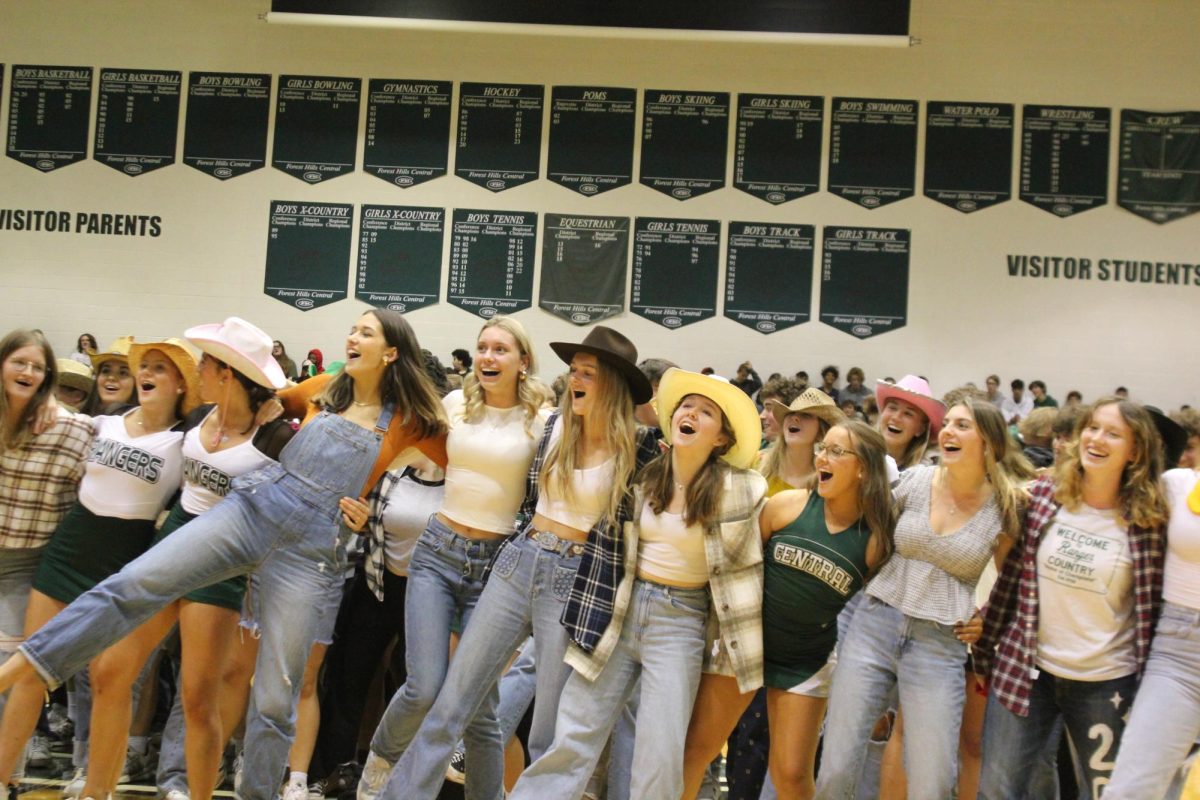As an upperclassman, many find freshman year to have been regrettable.
From not taking enough of the “right” classes to not spending enough of that now coveted free time with friends or even just picking a homecoming dress that—in retrospect—is plain ugly, freshman year can undoubtedly be a learning experience.
While some of these choices are inevitable—synonymous with growing up—school festivity participation doesn’t have to be.
Current freshman and student council representative Aayonah Spencer recognizes her grade’s hesitancy to show school spirit, specifically when it comes to the annual FHC homecoming lip sync.
“[I would encourage fellow freshmen to do the lip sync] because it is about the experience [of] high school,” Aayonah said. “I feel like we shouldn’t be looking back on the things we didn’t do and saying that we should have [done them].”
Advertised as the biggest homecoming in the state of Michigan, FHC goes through a green-and-white-colored, lively ordeal each autumn. Various activities get students into the mood of the season, including class banner making, class float construction, and class lip sync performing. Advertised as a competition between grade levels, the projects are judged by a panel of teachers, and the class with the best execution is declared the winner at the much-anticipated homecoming football game.
Each project is meticulously planned out and made to be the absolute most impressive it can be. And, if a class expects to win, they need to be, too.
With underclassmen hoping to upset the experienced senior class, competition is fierce, especially as it pertains to the lip syncs, which are debatably the largest indicator of who will win the contest.
For the choreographer of the junior class lip sync, junior Lydia Morey, the greatest key to success is the turnout of students.
“[The lip syncs] always look better with numbers,” Lydia said. “I think the more numbers there are, with everyone as a whole, the visuals look way better. [When] everyone’s out there, everyone has fun. Even if you don’t know [the dance perfectly], it’s okay. I think [more participation] always leaves a better overall impression. It’s [an activity] that everyone can do together and have a shared experience [through].”
Widespread involvement undoubtedly makes or breaks each homecoming routine, but even more important is that participants actually know what they’re doing. A persistent trend, especially in recent years, is that a bulk of students will come down to the gym floor to dance in the lip sync, having never attended a practice before.
The practices, typically hosted on Sundays in the weekends leading up to homecoming week (though they vary depending on the grade), are pivotal for participating members to attend. If not, students will not know the dance, making the entire routine appear disorderly and sporadic.
For longtime FHC social studies teacher and student council advisor Laura Stiles, the amount of clueless lip sync participants is disheartening.
“I think that more people could try to actually learn the dance instead of trying to follow the person next to them,” Stiles said. “You can really tell when people are cheesing out. The last couple of years, everybody has come onto the floor, even if they didn’t go to any practices. That makes me mad because it ruins it. [If] you didn’t practice, you [shouldn’t] get to [go] out there.”
While gathering many students to participate in the lip syncs might sound easy in theory, student council members know the difficulty of actually drumming up enthusiasm for the event, particularly when it comes to underclassmen.
The dances are amusing—both to watch and to participate in—but convincing the younger grades that this is true often proves to be tough, principally for those who have never experienced the liveliness of an FHC homecoming as a high school student.
Being unfamiliar with the traditions, often students new to FHC think the lip syncs are cheesy and would rather avoid participating in them.
“Yes, [I do think that the freshmen are nervous about performing at the homecoming assembly],” Aayonah said. “But, I feel like it’s less about the nerves and more about embarrassment.”
Granted, dancing in front of the entire school does feel daunting. But, with enough people and an enticing routine, even the youngest participants can look polished and put together.
However, in addition to mass participation, a pivotal factor of success is the lip sync routine itself. With a fluctuating number of members, limited judgment on what a lip sync should actually consist of, and guesswork of what students can physically achieve, student choreographers are posed with a tough task.
“In freshman year, I think I made the dance a lot more difficult and dancer-like [than in later years],” Lydia said. “Last year, and this year—progressively—I’ve made [the dance] more fun and lowkey. [I’ve] realized that I don’t think the dance moves are as cool, but [I know] that how fun [the routine] will be will make it better.”
Making the routine both easy and fun is typically a balance reached only in the latest years of high school. Naturally, as students gain seniority, their lip syncs become more refined with more elaborate routines, bolstered by widespread participation.
For Stiles, some of the lip sync routines of past homecomings have stuck with her. Most fondly, she recalls a senior lip sync when the class performed an animated-movie-centered performance. Virtually the entire grade was out on the floor, and almost all were dressed in costumes. Even better, the participants actually moved their lips to the words of the songs, a pivotal factor that often gets forgotten.
As a student danced in full-on Buzz Lightyear attire, with his synchronized classmates beside him, the remarkable performance left an impressive legacy behind.
“I feel like I always get blown away by the seniors,” Stiles said. “No matter what it is, they always seem to pull it together. It’s amazing how fun things are when everyone does them. [The lip syncs] aren’t very fun when there are just a few people. When everybody’s doing the same thing, there’s some kind of magic and camaraderie [to] it.”




























































































